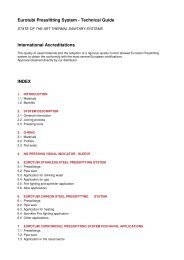Vis PDF - Damstahl
Vis PDF - Damstahl
Vis PDF - Damstahl
You also want an ePaper? Increase the reach of your titles
YUMPU automatically turns print PDFs into web optimized ePapers that Google loves.
Chapter 5: Ferritic, Stainless Steel<br />
General Corrosion<br />
General corrosion is a type of corrosion which takes place in either very strong acids or very strong<br />
alkalines. In these media, the austenites are normally slightly more resistant than the ferritic alternatives<br />
so for handling extreme pH media it is safer to stick to the traditional steel types.<br />
It should be mentioned that the different types of passive, stainless steel normally can be connected<br />
with no risk of galvanic corrosion provided that both types are sufficiently corrosion resistant.<br />
Normally, there is no corrosion problems connected with putting i.e. 4301 and 4509 together in the<br />
same media.<br />
Mechanical Properties<br />
Mechanically, the differences in between the austenitic and ferritic types are more evident. Measured<br />
by HRC, Rp 0.2 or Rm, most ferrites equal the austenitic steel types. However, ferritics possess<br />
slightly higher yield strength (Rp 0.2) and slightly lower tensile strength (Rm). As a rule, the mechanical<br />
properties of stainless ferrites are comparable to high strength carbon steels.<br />
A major difference in between the ferrites and the austenites is the elongation, i.e. the possible deformation<br />
until breakage. For the austenitic 4301 or 4401 groups, the minimum elongation is around<br />
45 % meaning that these steel types may be stretched and deformed very much before they break.<br />
In contrast, the ferritic types posses a minimum elongation of 18-20 % which means that they are<br />
much less useful in the case of mechanical deformation such as pure stretch forming. On the contrary,<br />
ferritics are more suitable for deep drawing, such as complex exhaust systems. As regards<br />
cold forming, the ferrites are comparable with carbon steels, and it is not necessary to use more<br />
powerful machines in comparison with cold forming of the austenitic steels.<br />
Notably, alloys like 4016 are widely used in i.e. England and Italy for catering purposes. However,<br />
do not expect to be able to make a very complicated double kitchen sink from a ferritic stainless<br />
steel. In such a case, the traditional 4301 is better.<br />
Another notable difference is the mechanical properties at extreme temperatures, i.e. notch<br />
toughness (AV) and creep strength, respectively, although Nb stabilized ferritics deform less than<br />
austenitics in response to long term stresses. Unlike the austenites, the ferrites may become<br />
brittle at very low temperatures, and they do not maintain their excellent tensile stress at very high<br />
temperatures (typically 7-800 ºC and above). In addition, long-term exposure to temperatures in<br />
between 400 and 550 °C may give rise to ”475°-brittleness”, an “illness” which may also attack the<br />
duplex stainless steels in the same temperature range.<br />
In short, the ferritic steels are less useful in extreme temperatures than the austenites; however,<br />
ferritics are more suited for cyclic high temperature applications while austenitics are preferably<br />
used in isothermal applications. In any case, each and every situation should be evaluated separately.<br />
www.damstahl.com<br />
01.2013<br />
300
















